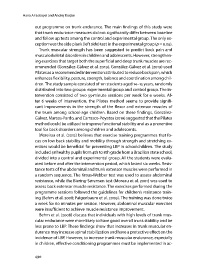Page 490 - Pedagoška vizija / A Pedagogical Vision
P. 490
Hana Al-Sobayel and Andrej Kocjan
out programme on trunk endurance. The main findings of this study were
that trunk endurance measures did not significantly differ between baseline
and follow up tests among the control and experimental group. The only ex-
ception was the side plank (left side) test in the experimental group (p =0.05).
Trunk muscular strength has been suggested to predict back pain and
musculoskeletal disorders in children and adolescents. However, strengthen-
ing exercises that target both the superficial and deep trunk muscles are rec-
ommended (González-Gálvez et al. 2019). González-Gálvez et al. (2019) used
Pilatesasarecommendedinterventionattributedto reduceback pain,which
enhances flexibility, posture, strength, balance and coordination among chil-
dren. The study sample consisted of 101 students aged 14–15 years, randomly
distributed into two groups: experimental group and control group. The in-
tervention consisted of two 55-minute sessions per week for 6 weeks. Af-
ter 6 weeks of intervention, the Pilates method seems to provide signifi-
cant improvements in the strength of the flexor and extensor muscles of
the trunk among school-age children. Based on these findings, González-
Gálvez,Marcos-Pardo,andCarrasco-Poyatos(2019)suggestedthatthePilates
method could be utilized to improve functional stability and as a preventive
tool for back disorders among children and adolescents.
Moreiraa et al. (2012) believes that exercise training programmes that fo-
cus on low back stability and mobility through strength and stretching ex-
ercises would be beneficial for preventing LBP in schoolchildren. The study
included 58 healthy pupils from 4th to 8th grade from a Brazilian state school,
divided into a control and experimental group. All the students were evalu-
ated before and after the intervention period, which lasted six weeks. Resis-
tance tests of the abdominal and trunk extensor muscles were performed in
a random sequence. The Kraus-Webber test was used to assess abdominal
resistance, while the Biering-Sørensen test (Moreau et al. 2001) was used to
assess back extensor muscle resistance. The exercises performed during the
programme sessions followed the guidelines for children’s resistance train-
ing (Behm et al. 2008; Faigenbaum et al. 2009). The training was done twice
a week for 60 minutes per session. However, abdominal muscular exercises
were insufficient to achieve muscle resistance improvement.
Behm et al. (2008) discuss that individuals with high levels of trunk mus-
cular endurance were more likely to have good overall trunk stability and be
less prone to LBP. These findings show that increases in trunk muscular en-
durance may increase spinal stabilization and have a protective effect on the
incidence of LBP. However, to increase trunk muscular endurance, especially
in children, effective conditioning programmes must be implemented in ac-
490

